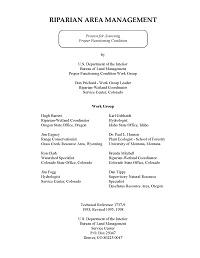Riparian Area Management: Process for Assessing Proper Functioning Condition

BLM Technical Reference 1737-9
The Bureau of Land Management (BLM) has responsibility for 269 million acres of public lands (USDI, 1992) that sustain a variety and abundance of resources. These resources are prized for their recreation, fish and wildlife, cultural, and historic values, as well as their economic values, and for such uses as livestock production, timber harvest, and mineral extraction. Riparian-wetland areas, though they comprise less than 9 percent of the total land base, are the most productive and highly prized resources found on BLM lands. Federal policy defines wetlands as areas that are inundated or saturated by surface or ground water at a frequency and duration sufficient to support, and which, under normal circumstances do support, a prevalence of vegetation typically adapted for life in saturated soil conditions. BLM Manual 1737, Riparian-Wetland Area Management, includes marshes, shallow swamps, lakeshores, bogs, muskegs, wet meadows, estuaries, and riparian areas as wetlands. BLM’s manual further defines riparian areas as a form of wetland transition between permanently saturated wetlands and upland areas. These areas exhibit vegetation or physical characteristics reflective of permanent surface or subsurface water influence. Lands along, adjacent to, or contiguous with perennially and intermittently flowing rivers and streams, glacial potholes, and the shores of lakes and reservoirs with stable water levels are typical riparian areas. Excluded are such sites as ephemeral streams or washes that do not exhibit the presence of vegetation dependent upon free water in the soil. Riparian-wetland areas are grouped into two major categories: 1) lentic, which is standing water habitat such as lakes, ponds, seeps, bogs, and meadows, and 2) lotic, which is running water habitat such as rivers, streams, and springs.
